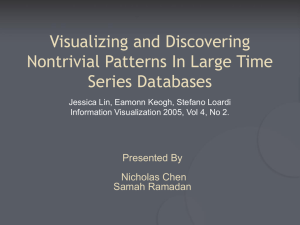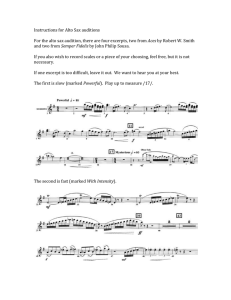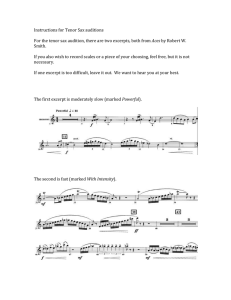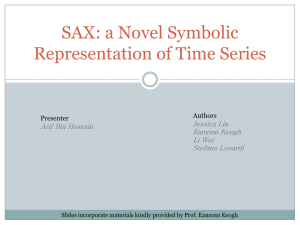SAX.ppt
advertisement
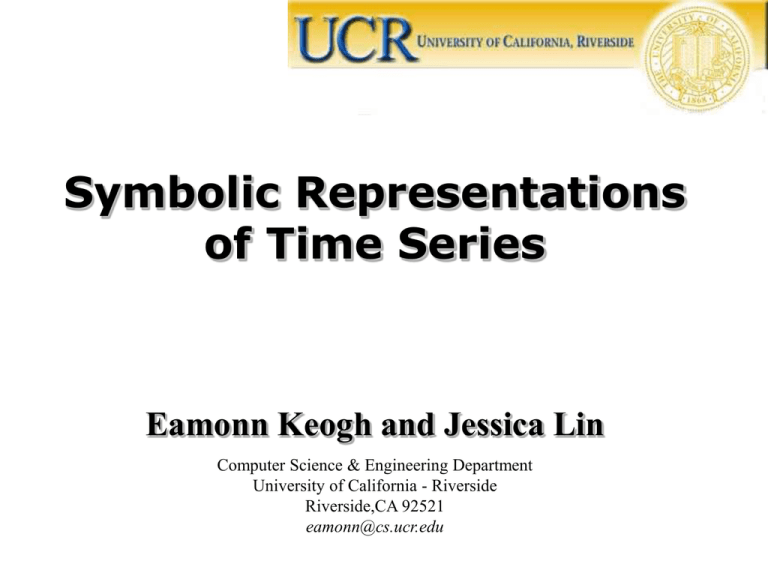
Symbolic Representations
of Time Series
Eamonn Keogh and Jessica Lin
Computer Science & Engineering Department
University of California - Riverside
Riverside,CA 92521
eamonn@cs.ucr.edu
Important! Read This!
These slides are from an early talk about SAX, some slides
will make little sense out of context, but are provided here to
give a quick intro to the utility of SAX. Read [1] for more
details.
You may use these slides for any teaching purpose, so long as they are
clearly identified as being created by Jessica Lin and Eamonn Keogh.
You may not use the text and images in a paper or tutorial without
express prior permission from Dr. Keogh.
[1] Lin, J., Keogh, E., Lonardi, S. & Chiu, B. (2003). A Symbolic Representation of Time
Series, with Implications for Streaming Algorithms. In proceedings of the 8th ACM
SIGMOD Workshop on Research Issues in Data Mining and Knowledge Discovery. San
Diego, CA. June 13.
Outline of Talk
• Prologue: Background on Time Series Data Mining
• The importance of the right representation
• A new symbolic representation
• motif discovery
• anomaly detection
• visualization
• Appendix: classification, clustering, indexing
25.1750
25.2250
25.2500
25.2500
25.2750
25.3250
25.3500
25.3500
25.4000
25.4000
25.3250
25.2250
25.2000
25.1750
..
..
24.6250
24.6750
24.6750
24.6250
24.6250
24.6250
24.6750
24.7500
What are Time Series?
A time series is a collection of observations
made sequentially in time.
29
28
27
26
25
24
23
0
50
100
150
200
250
300
350
400
450
500
Time Series are Ubiquitous! I
People measure things...
• Schwarzeneggers popularity rating.
• Their blood pressure.
• The annual rainfall in New Zealand.
• The value of their Yahoo stock.
• The number of web hits per second.
… and things change over time.
Thus time series occur in virtually every medical, scientific and
businesses domain.
Image data, may best be thought of as time series…
Video data, may best be thought of as time series…
Steady
pointing
Hand moving to
shoulder level
Point
Hand at rest
0
10
20
30
40
50
60
70
80
90
Steady
pointing
Hand moving to
shoulder level
Hand moving
down to grasp gun
Hand moving
above holster
Hand at rest
Gun-Draw
0
10
20
30
40
50
60
70
80
90
What do we want to do with the time series data?
Clustering
Motif Discovery
Classification
Rule
10
Discovery
Query by
Content
s = 0.5
c = 0.3
Novelty Detection
All these problems require similarity matching
Clustering
Motif Discovery
Classification
Rule
10
Discovery
Query by
Content
s = 0.5
c = 0.3
Novelty Detection
Euclidean Distance Metric
Given two time series
C
Q = q1…qn
and
Q
C = c1…cn
their Euclidean distance is
defined as:
DQ, C qi ci
n
i 1
2
D(Q,C)
The Generic Data Mining Algorithm
• Create an approximation of the data, which will fit in main
memory, yet retains the essential features of interest
• Approximately solve the problem at hand in main memory
• Make (hopefully very few) accesses to the original data on disk
to confirm the solution obtained in Step 2, or to modify the
solution so it agrees with the solution we would have obtained on
the original data
But which approximation
should we use?
Time Series
Representations
Data Adaptive
Sorted
Coefficients
Singular Symbolic
Piecewise
Value
Polynomial Decomposition
Piecewise
Linear
Approximation
Adaptive
Piecewise
Constant
Approximation
Natural
Language
Non Data Adaptive
Trees
Strings
Wavelets
Random
Mappings
Spectral
Orthonormal Bi-Orthonormal Discrete
Fourier
Transform
Haar Daubechies Coiflets
dbn n > 1
Interpolation Regression
Piecewise
Aggregate
Approximation
Discrete
Cosine
Transform
Symlets
UUCUCUCD
0
20 40 60 80 100 120
0
20 40 60 80 100 120
0
20 40 60 80 100 120
0
20 40 60 80 100 120
0
20 40 60 80 100 120
0
20 40 60 80 100 120
0
20 40 60 80 100120
U
U
C
U
C
U
D
D
DFT
DWT
SVD
APCA
PAA
PLA
SYM
The Generic Data Mining Algorithm (revisited)
• Create an approximation of the data, which will fit in main
memory, yet retains the essential features of interest
• Approximately solve the problem at hand in main memory
• Make (hopefully very few) accesses to the original data on disk
to confirm the solution obtained in Step 2, or to modify the
solution so it agrees with the solution we would have obtained on
the original data
This only works if the
approximation allows
lower bounding
What is lower bounding?
Exact (Euclidean) distance D(Q,S)
Lower bounding distance DLB(Q,S)
Q
Q’
S
S’
D(Q,S)
DLB(Q’,S’)
D(Q,S)
qi si
n
i 1
DLB(Q’,S’)
2
2
(
sr
sr
)(
qv
sv
)
i1 i i1 i i
M
Lower bounding means that for all Q and S, we have…
DLB(Q’,S’) D(Q,S)
Time Series
Representations
Data Adaptive
Sorted
Coefficients
Singular Symbolic
Piecewise
Value
Polynomial Decomposition
Piecewise
Linear
Approximation
Interpolation Regression
Adaptive
Piecewise
Constant
Approximation
Natural
Language
Non Data Adaptive
Trees
Strings
Wavelets
Random
Mappings
Spectral
Piecewise
Aggregate
Approximation
Orthonormal Bi-Orthonormal Discrete
Discrete
Fourier
Cosine
Transform Transform
Haar Daubechies Coiflets
dbn n > 1
Symlets
We can live without “trees”, “random mappings” and “natural
language”, but it would be nice if we could lower bound strings
(symbolic or discrete approximations)…
A lower bounding symbolic approach would allow data miners to…
• Use suffix trees, hashing, markov models etc
• Use text processing and bioinformatic algorithms
We have created the first
symbolic representation of time
series, that allows…
• Lower bounding of Euclidean distance
• Dimensionality Reduction
• Numerosity Reduction
We call our representation SAX
Symbolic Aggregate ApproXimation
baabccbc
How do we obtain SAX?
C
C
0
40
60
80
100
120
c
First convert the time
series to PAA
representation, then
convert the PAA to
symbols
It take linear time
20
c
c
b
b
a
0
20
b
a
40
60
80
100
baabccbc
120
c
b
b
a
0
Time series subsequences tend to have a
highly Gaussian distribution
0.999
0.997
0.99
0.98
Probability
0.95
0.90
0.75
0.50
0.25
0.10
0.05
0.02
0.01
0.003
0.001
-10
0
10
A normal probability plot of the (cumulative) distribution of
values from subsequences of length 128.
20
Why a
Gaussian?
a
40
60
80
Visual Comparison
3
2
1
0
-1
-2
-3
DFT
f
e
d
c
b
a
PLA
Haar
APCA
A raw time series of length 128 is transformed into the
word “ffffffeeeddcbaabceedcbaaaaacddee.”
– We can use more symbols to represent the time series since each symbol
requires fewer bits than real-numbers (float, double)
DQ, C qi ci
n
1.5
C
1
i 1
0.5
Euclidean Distance
0
-0.5
-1
Q
-1.5
0
20
40
60
80
100
120
DR (Q , C )
n
w
2
q
c
i 1 i i
w
1.5
C
1
PAA distance
lower-bounds
the Euclidean
Distance
0.5
0
-0.5
-1
Q
-1.5
0
Ĉ =
Q̂ =
20
40
baabccbc
babcacca
60
80
100
120
MINDIST (Qˆ , Cˆ )
n
w
2
ˆ
ˆ
dist
(
q
,
c
)
i 1
i
i
w
dist() can be implemented using a
table lookup.
2
SAX is just as good as
other representations, or
working on the raw data
for most problems (Slides
shown at the end of this
presentation)
Now let us consider SAX
for two hot problems,
novelty detection and
motif discovery
We will start with novelty
detection…
Novelty Detection
• Fault detection
• Interestingness detection
• Anomaly detection
• Surprisingness detection
…note that this problem should not be
confused with the relatively simple problem
of outlier detection. Remember Hawkins
famous definition of an outlier...
... an outlier is an observation
that deviates so much from
other observations as to arouse
suspicion that it was generated
from a different mechanism...
Thanks Doug, the check is in the
mail.
We are not interested in finding
individually surprising
datapoints, we are interested in
finding surprising patterns.
Douglas M. Hawkins
Lots of good folks have worked on
this, and closely related problems.
It is referred to as the detection of
“Aberrant Behavior1”, “Novelties2”,
“Anomalies3”, “Faults4”, “Surprises5”,
“Deviants6” ,“Temporal Change7”, and
“Outliers8”.
1.
2.
3.
4.
5.
6.
7.
8.
Brutlag, Kotsakis et. al.
Daspupta et. al., Borisyuk et. al.
Whitehead et. al., Decoste
Yairi et. al.
Shahabi, Chakrabarti
Jagadish et. al.
Blockeel et. al., Fawcett et. al.
Hawkins.
Arrr... what be wrong with
current approaches?
The blue time series at the top is a normal
healthy human electrocardiogram with an
artificial “flatline” added. The sequence in
red at the bottom indicates how surprising
local subsections of the time series are
under the measure introduced in Shahabi
et. al.
Our Solution
Based on the following intuition, a
pattern is surprising if its frequency of
occurrence is greatly different from
that which we expected, given
previous experience…
This is a nice intuition, but useless unless we can
more formally define it, and calculate it efficiently
Note that unlike all previous attempts to solve this
problem, our notion surprisingness of a pattern is not tied
exclusively to its shape. Instead it depends on the
difference between the shape’s expected frequency and
its observed frequency.
For example consider the familiar head and shoulders
pattern shown below...
The existence of this pattern in a stock market time series
should not be consider surprising since they are known to occur
(even if only by chance). However, if it occurred ten times this
year, as opposed to occurring an average of twice a year in
previous years, our measure of surprise will flag the shape as
being surprising. Cool eh?
The pattern would also be surprising if its frequency of
occurrence is less than expected. Once again our definition
would flag such patterns.
We call our algorithm… Tarzan!
“Tarzan” is not an
acronym. It is a pun on
the fact that the heart
of the algorithm relies
comparing two suffix
trees, “tree to tree”!
Homer, I hate to be a fuddyduddy, but could you put on
some pants?
Tarzan (R) is a registered
trademark of Edgar Rice
Burroughs, Inc.
We begin by defining some
terms… Professor Frink?
Definition 1: A time series pattern P,
extracted from database X is surprising
relative to a database R, if the
probability of its occurrence is greatly
different to that expected by chance,
assuming that R and X are created by the
same underlying process.
Definition 1: A time series pattern P,
extracted from database X is surprising
relative to a database R, if the
probability of occurrence is greatly
different to that expected by chance,
assuming that R and X are created by the
same underlying process.
But you can never know the
probability of a pattern you have
never seen!
And probability isn’t even defined
for real valued time series!
We need to discretize the time series
into symbolic strings… SAX!!
aaabaabcbabccb
Once we have done this, we can
use Markov models to calculate
the probability of any pattern,
including ones we have never
seen before
If x = principalskinner
is
{a,c,e,i,k,l,n,p,r,s}
|x| is 16
skin is a substring of x
prin is a prefix of x
ner is a suffix of x
If y = in, then fx(y) = 2
If y = pal, then fx(y) = 1
Can we do all this in linear space
and time?
Yes! Some very clever
modifications of
suffix trees (Mostly
due to Stefano
Lonardi) let us do this
in linear space.
An individual pattern
can be tested in
constant time!
Experimental Evaluation
We would like to demonstrate two
features of our proposed approach
Sensitive
and
Selective,
• Sensitivity (High True Positive Rate)
The algorithm can find truly surprising
patterns in a time series.
just like me
• Selectivity (Low False Positive Rate)
The algorithm will not find spurious
“surprising” patterns in a time series
Experiment 1: Shock ECG
Training data
Test data
(subset)
0
200
400
600
800
1000
1200
1400
1600
Tarzan’s level of
0
surprise
200
400
600
800
1000
1200
1400
1600
Experiment 2: Video (Part 1)
Training data
0
2000
4000
6000
8000
10000
12000
0
2000
4000
6000
8000
10000
12000
0
2000
4000
6000
8000
10000
12000
Test data
(subset)
Tarzan’s level of
surprise
We zoom in on this section in the next slide
Experiment 2: Video (Part 2)
400
350
300
Normal
sequence
250
Actor
misses
holster
200
150
100
0
100
200
300
Laughing and
flailing hand
Normal
sequence
Briefly swings gun at
target, but does not aim
400
500
600
700
Experiment 3: Power Demand (Part 1)
We consider a dataset that contains
the power demand for a Dutch
research facility for the entire year
of 1997. The data is sampled over 15 minute
Demand for
Power?
Excellent!
averages, and thus contains 35,040 points.
2500
2000
1500
1000
500
0
200
400
600
800
1000
1200
1400
1600
1800
2000
The first 3 weeks of the power demand dataset. Note the
repeating pattern of a strong peak for each of the five
weekdays, followed by relatively quite weekends
Experiment 3: Power Demand (Part 2)
Mmm..
anomalous..
We used from Monday January 6th to Sunday
March 23rd as reference data. This time
period is devoid of national holidays. We
tested on the remainder of the year.
We will just show the 3 most surprising
subsequences found by each algorithm. For
each of the 3 approaches we show the entire
week (beginning Monday) in which the 3
largest values of surprise fell.
Both TSA-tree and IMM returned sequences
that appear to be normal workweeks, however
Tarzan returned 3 sequences that correspond
to the weeks that contain national holidays in
the Netherlands. In particular, from top to
bottom, the week spanning both December
25th and 26th and the weeks containing
Wednesday April 30th (Koninginnedag,
“Queen's Day”) and May 19th (Whit
Monday).
Tarzan
TSA Tree
IMM
NASA recently said “TARZAN
holds great promise for the
future*”.
There is now a journal version
of TARZAN (under review), if
you would like a copy, just ask.
In the meantime, let us
consider motif discovery…
* Isaac, D. and Christopher Lynnes, 2003. Automated Data Quality Assessment in the Intelligent
Archive, White Paper prepared for the Intelligent Data Understanding program.
SAX allows Motif
Discovery!
Winding Dataset
( The angular speed of reel 2 )
0
50 0
1000
150 0
2000
Informally, motifs are reoccurring patterns…
2500
Motif Discovery
To find these 3 motifs would require about
6,250,000 calls to the Euclidean distance function.
A
0
500
20
1500
2000
B
40
60
80
100
120
140
0
20
C
(The angular speed of reel 2)
1000
A
0
Winding Dataset
B
2500
C
40
60
80
100
120
140
0
20
40
60
80
100
120
140
Why Find Motifs?
· Mining association rules in time series requires the discovery of motifs.
These are referred to as primitive shapes and frequent patterns.
· Several time series classification algorithms work by constructing typical
prototypes of each class. These prototypes may be considered motifs.
· Many time series anomaly/interestingness detection algorithms essentially
consist of modeling normal behavior with a set of typical shapes (which we see
as motifs), and detecting future patterns that are dissimilar to all typical shapes.
· In robotics, Oates et al., have introduced a method to allow an autonomous
agent to generalize from a set of qualitatively different experiences gleaned
from sensors. We see these “experiences” as motifs.
· In medical data mining, Caraca-Valente and Lopez-Chavarrias have
introduced a method for characterizing a physiotherapy patient’s recovery
based of the discovery of similar patterns. Once again, we see these “similar
patterns” as motifs.
• Animation and video capture… (Tanaka and Uehara, Zordan and Celly)
T
Trivial
Matches
Space Shuttle STS - 57 Telemetry
C
0
100
200
3 00
400
( Inertial Sensor )
500
600
70 0
800
900
100 0
Definition 1. Match: Given a positive real number R (called range) and a time series T containing a
subsequence C beginning at position p and a subsequence M beginning at q, if D(C, M) R, then M is
called a matching subsequence of C.
Definition 2. Trivial Match: Given a time series T, containing a subsequence C beginning at position
p and a matching subsequence M beginning at q, we say that M is a trivial match to C if either p = q
or there does not exist a subsequence M’ beginning at q’ such that D(C, M’) > R, and either q < q’< p
or p < q’< q.
Definition 3. K-Motif(n,R): Given a time series T, a subsequence length n and a range R, the most
significant motif in T (hereafter called the 1-Motif(n,R)) is the subsequence C1 that has highest count
of non-trivial matches (ties are broken by choosing the motif whose matches have the lower
variance). The Kth most significant motif in T (hereafter called the K-Motif(n,R) ) is the subsequence
CK that has the highest count of non-trivial matches, and satisfies D(CK, Ci) > 2R, for all 1 i < K.
OK, we can define motifs, but
how do we find them?
The obvious brute force search algorithm is just too slow…
Our algorithm is based on a hot idea from bioinformatics,
random projection* and the fact that SAX allows use to
lower bound discrete representations of time series.
* J Buhler and M Tompa. Finding motifs using random projections. In
RECOMB'01. 2001.
A simple worked example of our motif discovery algorithm
The next 4 slides
T
0
500
( m= 1000)
1000
C1
C^1 a c b a
^
S
1 a
2 b
: :
: :
58 a
: :
985 b
c
c
:
:
c
:
c
b
a
:
:
c
:
c
a
b
:
:
a
:
c
a = 3 {a,b,c}
n = 16
w=4
Assume that we have a
time series T of length
1,000, and a motif of
length 16, which occurs
twice, at time T1 and
time T58.
A mask {1,2} was randomly chosen,
so the values in columns {1,2} were
used to project matrix into buckets.
Collisions are recorded by
incrementing the appropriate
location in the collision matrix
A mask {2,4} was randomly chosen,
so the values in columns {2,4} were
used to project matrix into buckets.
Once again, collisions are
recorded by incrementing the
appropriate location in the
collision matrix
We can calculate the expected values in the
matrix, assuming there are NO patterns…
k i
E( k , a, w, d , t ) 1-
2 i 0 w
d
t
w a 1
i a
i
1
a
w i
1
Suppose
E(k,a,w,d,t) = 2
2
2
:
1
3
58 27
: 3
2
1
2
2
1
985 0
1
2
1
1
2
:
58
3
: 985
A Simple Experiment
Lets imbed two motifs into a random walk time
series, and see if we can recover them
C
A
D
B
0
0
20
40
60
200
80
100
120
400
0
20
40
600
60
80
100
800
120
1000
1200
Planted Motifs
C
A
B
D
“Real” Motifs
0
20
40
60
80
100
120
0
20
40
60
80
100
120
Some Examples of Real Motifs
Motor 1 (DC Current)
0
500
1000
1500
2000
Astrophysics (Photon Count)
250
0
350
0
450
0
550
0
650
0
How Fast can we find Motifs?
Seconds
10k
8k
Brute Force
6k
TS-P
4k
2k
0
1000
2000
3000
4000
Length of Time Series
5000
Let us very quickly look at some
other problems where SAX may
make a contribution
• Visualization
• Understanding the “why” of classification and clustering
Understanding the “why” in classification and clustering
SAX Summary
• For most classic data mining tasks
(classification, clustering and
indexing), SAX is at least as good as
the raw data, DFT, DWT, SVD etc.
• SAX allows the best anomaly
detection algorithm.
• SAX is the engine behind the only
realistic time series motif discovery
algorithm.
The Last Word
The sun is setting on all other
symbolic representations of
time series, SAX is the only
way to go
Conclusions
• SAX is posed to make major contributions to
time series data mining in the next few years.
•A more general conclusion, if you want to
solve you data mining problem, think
representation, representation, representation.
The slides that follow demonstrate that
SAX is as good as DFT, DWT etc for the
classic data mining tasks, this is
important, but not very exciting, thus
relegated to this appendix.
Experimental Validation
• Clustering
– Hierarchical
– Partitional
• Classification
– Nearest Neighbor
– Decision Tree
• Indexing
– VA File
• Discrete Data only
– Anomaly Detection
– Motif Discovery
Clustering
• Hierarchical Clustering
– Compute pairwise distance, merge similar
clusters bottom-up
– Compared with Euclidean, IMPACTS, and
SDA
Hierarchical Clustering
Euclidean
IMPACTS (alphabet=8)
Hierarchical Clustering
SAX
SDA
Clustering
• Hierarchical Clustering
– Compute pairwise distance, merge similar clusters
bottom-up
– Compared with Euclidean, IMPACTS, and SDA
• Partitional Clustering
– K-means
– Optimize the objective function by minimizing the sum
of squared intra-cluster errors
– Compared with Raw data
Partitional (K-means) Clustering
265000
260000
Raw
Rawdata
data
Objective Function
255000
Our
Symbolic
SAX
Approach
250000
245000
240000
235000
230000
225000
220000
1
2
3
4
5
6
7
8
9
Number of Iterations
Partitional (k-means) Clustering
10
11
Classification
• Nearest Neighbor
– Leaving-one-out cross validation
– Compared with Euclidean Distance, IMPACTS,
SDA, and LP
– Datasets: Control Charts & CBF (Cylinder,
Bell, Funnel)
Nearest Neighbor
Cylinder-Bell-Funnel
Control Chart
0.6
0.5
Impacts
0.4
Error Rate
SDA
0.3
Euclidean
LPmax
0.2
SAX
0.1
0
5
6
7
8
Alphabet Size
9
10
5
6
7
8
Alphabet Size
Nearest Neighbor
9
10
Classification
• Nearest Neighbor
– Leaving-one-out cross validation
– Compared with Euclidean Distance, IMPACTS, SDA,
and LP
– Datasets: Control Charts & CBF (Cylinder, Bell,
Funnel)
• Decision Tree
– Defined for real data, but attempting to use DT on time
series raw data would be a mistake
Adaptive Piecewise
Constant Approximation
• High dimensionality/Noise level would result in deep, bushy
trees
– Geurts (’01) suggests representng time series as
Regression Tree, and training decision tree on it.
0
50
100
Decision (Regression) Tree
Dataset
SAX
Regression Tree
CC
3.04 1.64
2.78 2.11
CBF
0.97 1.41
1.14 1.02
Indexing
• Indexing scheme similar to VA (Vector
Approximation) File
– Dataset is large and disk-resident
– Reduced dimensionality could still be too high
for R-tree to perform well
• Compare with Haar Wavelet
Indexing
0.6
0.5
DWT
0.4
SAX
Haar
0.3
0.2
0.1
0
Ballbeam
Chaotic
Memory
Dataset
Winding
